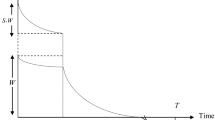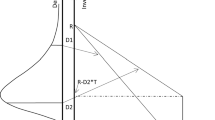Abstract
The backroom effect (BRE) constitutes the handling effort of a replenishment that does not fit on the shelf of a retailer. This effect needs to be included in the decision making of inventory policy parameters as it influences the handling effort, which constitutes a major part of the retailer’s operational cost. We propose a mixed integer linear program to calculate the parameters of a periodic review (s, c, S, nq) policy while considering the BRE. The (s, c, S, nq) policy triggers an order when inventory drops below the reorder point s. Also, an order is triggered whenever the inventory drops below the can-order point c, provided at least one other product’s inventory level is below s and thus ordered. The order then comprises the smallest integer number n of case packs with size q that brings the inventory level to or above S. As retailers face stochastic non-stationary demand, a data-driven approach based on historical data is applied to this joint replenishment problem. The numerical study shows that including the BRE into the optimization can lead to cost savings with a median of 0.96% compared to neglecting its effects. Considering the stochasticity in the decision making, cost improvements with a median of 53.23% have been realized against an approach that only considers average daily demands and a safety stock. The advantage of an (s, c, S, nq) order policy over an (s, S, nq) policy is shown by median savings of 17.99%.





Similar content being viewed by others
References
Adan I, Van Eenige M, Resing J (1995) Fitting discrete distributions on the first two moments. Probab Eng Inf Sci 9(4):623–632
Aksoy Y, Erenguc SS (1988) Multi-item inventory models with co-ordinated replenishments: a survey. Int J Oper Prod Manag 8(1):63–73
Amorim P, Costa AM, Almada-Lobo B (2014) Influence of consumer purchasing behaviour on the production planning of perishable food. OR Spectr 36:669–692
Atan Z, Erkip N (2015) Note on “The Backroom Effect in retail operations”. Prod Oper Manag 24(11):1833–1834
Balintfy JL (1964) On a basic class of multi-item inventory problems. Manag Sci 10(2):287–297
Ban G-Y, Rudin C (2017) The big data newsvendor: practical insights from machine learning. https://doi.org/10.2139/ssrn.2559116
Bertsimas D, Doan XV (2010) Robust and data-driven approaches to call centers. Eur J Oper Res 207(2):1072–1085
Bertsimas D, Thiele A (2006) A robust optimization approach to inventory theory. Oper Res 54(1):150–168
Bertsimas D, Thiele A (2014) Robust and data-driven optimization: modern decision making under uncertainty. In: Johnson M, Norman B, Secomandi N (eds) Models, methods, and applications for innovative decision making. INFORMS Tutorials in Operations Research, Hanover, pp 95–122
Beutel AL, Minner S (2012) Safety stock planning under causal demand forecasting. Int J Prod Econ 140(2):637–645
Bijvank M, Vis I (2011) Lost-sales inventory theory: a review. Eur J Oper Res 215(1):1–13
Bookbinder JH, Tan JY (1988) Strategies for the probabilistic lot-sizing problem with service-level constraints. Manag Sci 34(9):1096–1108
Brijs T, Swinnen G, Vanhoof K, Wets G (1999) Using association rules for product assortment decisions: a case study. In: Proceedings of the fifth international conference on knowledge discovery and data mining, San Diego (USA), pp 254–260
Broekmeulen RACM, Van Donselaar KH (2004) Excess shelf space in retail stores: an analytical model and empirical assessment. BETA publicatie: working papers, Technische Universiteit Eindhoven, Eindhoven, vol 109, pp 1–26
Broekmeulen RACM, Sternbeck MG, Van Donselaar KH, Kuhn H (2017) Decision support for selecting the optimal product unpacking location in a retail supply chain. Eur J Oper Res 259(1):84–99
Corsten D, Gruen T (2003) Desperately seeking shelf availability: an examination of the extent, the causes, and the efforts to address retail out-of-stocks. Int J Retail Distrib Manag 31(12):605–617
Curşeu A, Van Woensel T, Fransoo JC, Van Donselaar KH, Broekmeulen RACM (2009) Modelling handling operations in grocery retail stores: an empirical analysis. J Oper Res Soc 60(2):200–214
DeHoratius N, Ton Z (2009) The role of execution in managing product availability. In: Agrawal NM, Smith SA (eds) Retail supply chain management. Springer, New York, pp 53–77
East R, Lomax W, Willson G, Harris P (1994) Decision making and habit in shopping times. Eur J Mark 28(4):56–71
Ehrenthal JCF, Honhon D, Van Woensel T (2014) Demand seasonality in retail inventory management. Eur J Oper Res 238(2):527–539
Eroglu C, Williams BD, Waller MA (2011) Consumer-driven retail operations: the moderating effects of consumer demand an case pack quantity. Int J Phys Distrib Logist Manag 41(5):420–434
Eroglu C, Williams BD, Waller MA (2013) The Backroom Effect in retail operations. Prod Oper Manag 22(4):915–923
Feng H, Wu Q, Muthuraman K, Deshpande V (2015) Replenishment policies for multi-product stochastic inventory systems with correlated demand and joint-replenishment costs. Prod Oper Manag 24(4):647–664
Gaur V, Fisher ML (2004) A periodic inventory routing problem at a supermarket chain. Oper Res 52(6):813–822
Goyal SK, Satir AT (1989) Joint replenishment inventory control: deterministic and stochastic models. Eur J Oper Res 38:2–13
Holzapfel A, Hübner AH, Kuhn H, Sternbeck MG (2016) Delivery pattern and transportation planning in grocery retailing. Eur J Oper Res 252:54–68
Hua Z, Yang J, Huang F, Xu X (2009) A static-dynamic strategy for spare part inventory systems with nonstationary stochastic demand. J Oper Res Soc 60(9):1254–1263
Hübner AH, Kuhn H, Sternbeck MG (2013) Demand and supply chain planning in grocery retail: an operations planning framework. Int J Retail Distrib Manag 41(7):512–530
Huh WT, Levi R, Rusmevichientong P, Orlin JB (2011) Adaptive data-driven inventory control with censored demand based on Kaplan-Meier estimator. Oper Res 59(4):929–941
Iyer AV, Schrage LE (1992) Analysis of the deterministic \((s, S)\) inventory problem. Manag Sci 38(9):1299–1313
Johansen SG, Melchiors P (2003) Can-order policy for the periodic-review joint replenishment problem. J Oper Res Soc 54(3):283–290
Kahn BE, Schmittlein DC (1989) Shopping trip behavior: an empirical investigation. Mark Lett 1(1):55–69
Khouja M, Goyal SK (2008) A review of the joint replenishment problem literature: 1989–2005. Eur J Oper Res 186(1):1–16
Kouki C, Babai MZ, Jemai Z, Minner S (2016) A coordinated multi-item inventory system for perishables with random lifetime. Int J Prod Econ 181:226–237
Kuhn H, Wensing T, Sternbeck MG (2015) Evaluation of case-pack sizes in grocery retailing using a Markov Chain approach. In: Liberopoulos G (ed) 10th Conference on stochastic models of manufacturing and service operations (SMMSO 2015). University of Thessaly Press, Volos, pp 103–110
Law AM (2015) Simulation modeling and analysis, 5th edn. Mc Graw Hill, New York
Martel A, Diaby M, Boctor FF (1995) Multiple items procurement under stochastic nonstationary demands. Eur J Oper Res 87(1):74–92
Nagasawa K, Irohara T, Matoba Y, Liu S (2015) Applying genetic algorithm for can-order policies in the joint replenishment problem. Ind Eng Manag Syst 14(1):1–10
Ohno K, Tomonori I, Toshiaki Y (1994) A new algorithm for a multi-item periodic review inventory system. Math Method Oper Res 39:349–364
Pires M, Amorim P, Liz J, Pratas J (2015) Design of retail backroom storage: a research opportunity? In: Póvoa A, de Miranda J (eds) Operations research and big data, Studies in Big Data, vol 15. Springer, Cham, pp 167–174
Raman A, DeHoratius N, Ton Z (2001) Execution: the missing link in retail operations. Calif Manag Rev 43(3):136–152
Reiner G, Teller C, Kotzab H (2013) Analyzing the efficient execution of in-store logistics processes in grocery retailing-the case of dairy products. Prod Oper Manag 22(4):924–939
Sachs AL, Minner S (2014) The data-driven newsvendor with censored demand observations. Int J Prod Econ 149:28–36
Saliby E (1990) Descriptive sampling: a better approach to Monte Carlo simulation. J Oper Res Soc 41(12):1133–1142
Silver EA (1974) A control system for coordinated inventory replenishment. Int J Prod Res 12(6):647–671
Silver EA, Pyke DF, Peterson R (1998) Inventory management and production planning and scheduling, 3rd edn. Wiley, New York
Sternbeck MG (2015) A store-oriented approach to determine order packaging quantities in grocery retailing. J Bus Econ 85:569–596
Sternbeck MG, Kuhn H (2014) An integrative approach to determine store delivery patterns in grocery retailing. Transp Res Part E 70:205–224
Taube F, Minner S (2017) Data-driven assignment of delivery patterns in retail with handling effort considerations. Comput Oper Res. https://doi.org/10.1016/j.cor.2017.08.004 (forthcoming)
Tempelmeier H, Hilger T (2015) Linear programming models for a stochastic dynamic capacitated lot sizing problem. Comput Oper Res 59:119–125
Ton Z, Raman A (2010) The effect of product variety and inventory levels on retail store sales: a longitudinal study. Prod Oper Manag 19(5):546–560
Tsai CY, Tsai CY, Huang PW (2009) An association clustering algorithm for can-order policies in the joint replenishment problem. Int J Prod Econ 117:30–41
Van Donselaar KH, Broekmeulen RACM (2013) Determination of safety stocks in a lost sales inventory system with periodic review, positive lead-time, lot-sizing and a target fill rate. Int J Prod Econ 143(2):440–448
Van Donselaar KH, Van Woensel T, Broekmeulen RACM, Fransoo JC (2006) Inventory control of perishables in supermarkets. Int J Prod Econ 104(2):462–472
Van Donselaar KH, Gaur V, Van Woensel T, Broekmeulen RACM, Fransoo JC (2010) Ordering behavior in retail stores and implications for automated replenishment. Manag Sci 56(5):766–784
Van Woensel T, Erkip N, Curşeu A, Fransoo JC (2013) Lost sales inventory models with batch ordering and handling costs. BETA publicatie: working papers, Technische Universiteit Eindhoven, Eindhoven, vol 421, pp 1–34
Van Zelst S, Van Donselaar KH, Van Woensel T, Broekmeulen RACM, Fransoo JC (2009) Logistics drivers for shelf stacking in grocery retail stores: potential for efficiency improvement. Int J Prod Econ 121(2):620–632
Waller MA, Heintz A, Brent T (2008) Case pack quantity’s effect on retail market share: an examination of the backroom logistics effect and the store-level fill rate effect. Int J Phys Distrib Logist Manag 38(6):436–451
Acknowledgements
The authors would like to thank the three anonymous reviewers for their constructive comments.
Author information
Authors and Affiliations
Corresponding author
Rights and permissions
About this article
Cite this article
Turgut, Ö., Taube, F. & Minner, S. Data-driven retail inventory management with backroom effect. OR Spectrum 40, 945–968 (2018). https://doi.org/10.1007/s00291-018-0511-9
Received:
Accepted:
Published:
Issue Date:
DOI: https://doi.org/10.1007/s00291-018-0511-9




